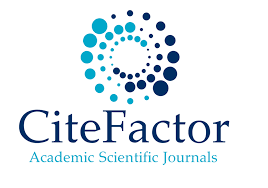PENGARUH CURRENT RATIO, DEBT TO EQUITY RATIO, DAN TOTAL ASSETS TURN OVER TERHADAP RETURN ON ASSETS PADA PT. KALBE FARMA TBK PERIODE 2008 - 2021
DOI:
https://doi.org/10.36277/geoekonomi.v13i2.209Keywords:
Current Ratio, Debt to Equity Ratio, Total Assets Turn Over, Return On AssetsAbstract
This research aims to analyze the influence of Current Ratio, Debt to Equity Ratio, Total Assets Turn Over toward of Return On Assets at PT. Kalbe Farma Tbk. Period of 2008 - 2021. Data Analyse method that used in this research are Multiple Linier Regression Analyse (correlation coeficient, determination coeficient, simultaneous test/F test, and partial test/t test). Accumulatively, coeficient correlation (R)= 0,898 so that it can be said that the independent variables toward dependent variable in this research can giving the very strength correlation. Result of determination coefficient (R2)= 0,749 it can be said the independent variables can be explain the dependent variable of equal to 74,9% only. While the rest equal to 25,1% explained by other variable from outside model. The result of significantion test could be explained:(1) Current Ratio variable have negative  effect and significant on the Return On Assets variable;(2) Debt to Equity Ratio variable have no effect and significant on the Return On Assets variable; and (3) Total Assets Turn Over variable have positive effect and significant on the Return On Assets variable. The result of simultaneous test could be explained: variables of Current Ratio, Debt to Equity Ratio, and Total Assets Turn Over simultaneously have effect and significant on the Return On Assets variable.
Downloads
References
Dewi, F. A. (2021). Pengaruh Current Ratio, Total Assets Turnover dan Debt to Equity Ratio terhadap Return On Asset pada Perusahaan Farmasi yang terdaftar di Bursa Efek Indonesia pada tahun 2016-2020.
Hantono. (2018). Konsep Analisa Laporan Keuangan dengan Pendekatan Rasio dan SPSS. Sleman: CV. Budi Utama.
Harianto, Rudy Pudjut. (2017). Panduan Praktis SPSS untuk Penelitian. Balikpapan: Heart & Soul Media Aksara.
Kasmir. (2017). Analisis Laporan Keuangan. Jakarta: PT. Raja Grafindo Perkasa.
Kasmir. (2019). Analisa Laporan Keuangan. Jakarta: PT. Raja Grafindo Persada.
Ningsih, F. (2021). Pengaruh Debt to Equity Ratio (DER), Current Ratio (CR), Total Assets Turn Over (TATO) dan Net Profit Margin (NPM) terhadap Retun On Assets (ROA).
Pasaribu, E. J. (2015). Pengaruh Current Ratio (CR), Debt to Equity Ratio (DER) dan Total Assets Turn Over (TATO) terhadap Return On Assets (ROA) pada Industri Barang Konsumsi yang terdaftar di BEI.
Prakoso, P. G. (2016). Analisis Pengaruh Current Ratio, Size, Debt to Equity Ratio dan Total Asset Turnover terhadap Devidend Yield dengan Return On Asset sebagai Variabel Intervening. 1-23.
Priyatno, Duwi. 2014. SPSS 22 : Pengolahan Data Ter-praktis. Yogyakarta: ANDI Offset.
Putri, M. A. (2019). Pengaruh Current Ratio, Debt to Equity Ratio dan Inventory Turnover terhadap Return On Assets pada PT Kalbe Farma Tbk periode 2006-2018. Fakultas Ekonomi 2019.
Sugiyono. 2011. Metode Penelitian Kuantitatif, Kualitatif, dan R & D. Bandung: CV. Alfabeta.
Sugiyono. 2017. Metode Penelitian Bisnis. Cetakan Kelima Belas. Alfabeta. Bandung.
Sujarweni, Wiratna. 2015. SPSS untuk Penelitian. Yogyakarta : Pustaka Baru Press.
Sujarweni, Wiratna. (2017). Analisis Laporan Keuangan: Teori, Aplikasi & Hasil Penelitian. Yogyakarta: Pustaka Baru Press.
Sujarweni, Wiratna. (2017). Analisa Kinerja Keuangan. Yogyakarta: Pustaka Baru Press.
Sukamulja, S. (2017). Analisis laporan keuangan sebagai dasar pengambilan keputusan investasi. Yogyakarta: ANDI.
Syamsudin. (2016). Manajemen Keuangan Perusahaan. Jakarta: PT Raja Grafindo Persada.
Umar, Husein. 2010. Desain Penelitian MSDM dan Perilaku Karyawan Paradigma Positivistik dan Berbasis Pemecahan Masalah. Jakarta : PT RajaGrafindo Persada.
Downloads
Published
How to Cite
Issue
Section
License
You are free to:
Share - copy and redistribute the materials in any medium or format for any purpose, even for commercial purposes.
Adapt - compose, change and develop the material for any purpose, even for commercial purposes.
The licensor cannot revoke these freedoms as long as you follow the license terms.
With the following conditions:
Attribution - you must give appropriate credit, provide a link to the license, and indicate if changes have been made. You may do so in a reasonable manner, but not in any way that suggests that the licensor endorses you or your use.
No additional restrictions - You may not implement legal provisions or technological measures that legally restrict others from doing anything permitted by the license.
Notice:
You do not have to comply with the license for elements of the material that are in the public domain or where your use is permitted by an applicable exclusion or restriction.
No warranties are given. This license may not grant all the permissions necessary for your intended use. For example, other rights such as publicity, privacy, or moral rights may limit how you use the material.







_geoekonomi.png)
_geoekonomi.png)
















